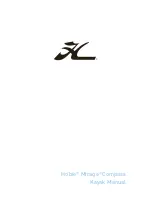
Section 02 ENGINE
Subsection 10 (CYLINDER HEAD)
GENERAL
NOTE:
When diagnosing an engine problem, al-
ways perform an engine leak test. This will help
pin-point a problem. Refer to
ENGINE LEAK TEST
in this subsection for procedures.
Always place the vehicle on level surface.
Always disconnect the negative wire from the bat-
tery before working on the engine.
Even if the removal of many parts is not neces-
sary to reach another part, it is recommended to
remove these parts in order to check them.
When disassembling parts that are duplicated in
the engine, (e.g.: valves, bushings), it is strongly
recommended to note their position (cylinder 1, 2
or 3) and to keep them as a “group”. If you find
a defective component, it would be much easier
to find the cause of the failure within the group of
parts (e.g.: you found a worn valve guide. A bent
spring could be the cause and it would be easy to
know which one among the springs is the cause
to replace it if you grouped them at disassembly).
Besides, since used parts have matched together
during the engine operation, they will keep their
matched fit when you reassemble them together
within their “group”.
During assembly/installation, use torque values
and service products as in the exploded view.
Clean threads before applying a threadlocker. Re-
fer to
SELF-LOCKING FASTENERS
and
LOCTITE
APPLICATION
at the beginning of this manual for
complete procedure.
WARNING
Torque
wrench
tightening
specifications
must be strictly adhered to.
Locking devices (e.g.: locking tabs, elastic
stop nuts, self-locking fasteners, cotter pins,
etc.) must be replaced with new ones.
Hoses, cable or locking ties removed during the
removal must be reinstalled as per factory stan-
dards.
INSPECTION
ENGINE LEAK TEST
The procedure has to be done when engine oper-
ating temperature of approximately 70°C (158°F)
is reached.
WARNING
Be careful to burns when working on a hot
engine.
Preparation
1. Remove any required parts to give access to
engine.
2. Remove safety lanyard.
WARNING
Safety lanyard must be removed to prevent
engine to be cranked while fuel rail is re-
moved to prevent fuel to be sprayed out.
Fuel is flammable.
3. Remove jet pump (refer to
JET PUMP
subsec-
tion).
4. Remove coolant pressure cap.
WARNING
To avoid potential burns, only remove the
coolant pressure cap by wearing the appro-
priate safety equipment.
5. Remove oil dipstick.
smr2009-025-002_a
1. Oil dipstick
6. Unplug and remove ignition coils.
7. Remove spark plugs.
NOTE:
Ignition coil may be used as an extractor.
smr2009-025
129
Summary of Contents for GTX Limited iS 255 2009
Page 1: ......
Page 2: ...2009 Shop Manual RXT iS 255 GTX LIMITED iS 255 ...
Page 23: ...XX smr2009 011 ...
Page 27: ...4 ...
Page 29: ...6 ...
Page 33: ...10 ...
Page 37: ...14 ...
Page 47: ...24 ...
Page 53: ...30 ...
Page 59: ...36 ...
Page 81: ...58 ...
Page 107: ...84 ...
Page 171: ...148 ...
Page 195: ...172 ...
Page 209: ...186 ...
Page 235: ...212 ...
Page 275: ...252 ...
Page 303: ...280 ...
Page 319: ...296 ...
Page 335: ...312 ...
Page 381: ...358 ...
Page 395: ...372 ...
Page 449: ...426 ...
Page 489: ...466 ...
Page 551: ......
Page 552: ...NOTES ...
Page 553: ...NOTES ...
Page 554: ...2009 Sea Doo 4 TEC iTC iS Series RXT iS 255 GTX Limited iS 255 smr2009 045 001 ...
Page 555: ...IGNITION SYSTEM CHARGING SYSTEM STARTING SYSTEM smr2009 045 002 ...
















































